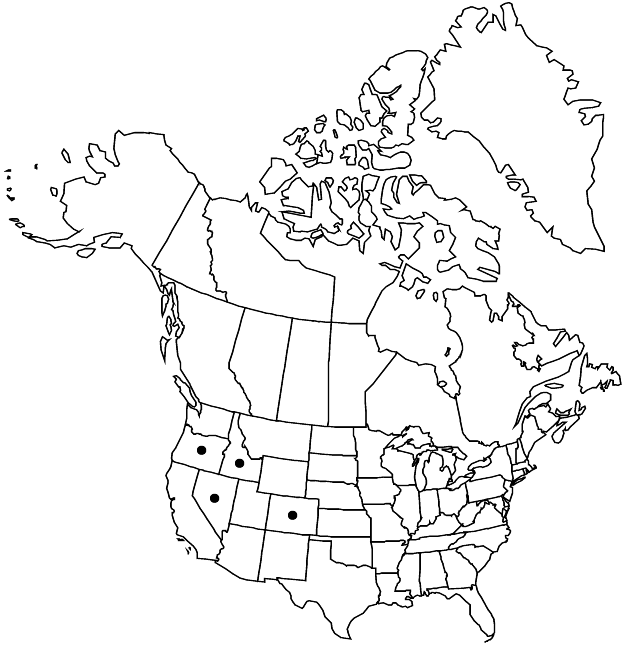Silene scaposa
Proc. Amer. Acad. Arts 28: 145. 1893.
Plants perennial, subscapose, cespitose; taproot stout; caudex branched, woody. Stems several, erect, simple, 15–50 cm, puberulent, viscid-glandular distally. Leaves mostly basal; basal marcescent, long-petiolate, densely tufted, blade 1-veined, narrowly oblanceolate, 2–10(–20) cm × 2–12(–20) mm, not fleshy, base tapering to petiole, apex acute to obtuse, finely puberulent on both surfaces; cauline in 1–3 pairs, sessile, much reduced, blade linear-lanceolate, not fleshy. Inflorescences 1–5(–7)-flowered, with terminal flower and lateral, open, pedunculate cymes often reduced to single flowers, bracteate; bracts narrowly lanceolate, 3–10(–20) mm. Pedicels erect, elongate, 0.5–4.5 cm, glandular-puberulent. Flowers: calyx prominently 10-veined, those to lobes lance-shaped broadened and thickened distally, commissural veins slender, not forked distally, campanulate, 10–12 × 3.5–5 mm in flower, enlarging to 15 × 10 mm in fruit, not contracted around carpophore, papery, margins dentate, glandular-pubescent, viscid, veins parallel, with pale commissures, lobes patent, ovate, 1.5–4 mm, rigid, margins broad, membranous; corolla off-white to dingy purple-red, clawed, claw exceeding calyx, ciliate proximally, broadened distally, limbs erect, 2–4-lobed, less than 1/2 length of calyx, lobes 2–5 mm, appendages 2–4, 0.5–1 mm; stamens slightly exserted; filaments lanate, expanded at base; styles 3–5, ± equaling calyx. Capsules slightly longer than calyx, opening by 3–5 teeth; carpophore 1.5–2.5 mm. Seeds brown, reniform, 1.2–2 mm, margins with large, inflated papillae, rugose on sides. 2n = 48.
Phenology: Flowering early summer.
Habitat: Subalpine grassy, gravelly, or rocky slopes, ponderosa pine forests, juniper scrub, sagebrush
Elevation: 900-3000 m
Distribution

Colo., Idaho, Nev., Oreg.
Discussion
Silene scaposa is a very distinct species with its subscapose inflorescence, coronalike ring of short petals, and distended fruiting calyx in which the veins to the lobes are markedly broadened and lanceolate. Variation in lobing of the corolla has been the basis for recognizing two varieties: var. scaposa (var. typica C. L. Hitchcock & Maguire), which has two-lobed petals, and var. lobata, which has four-lobed petals. However, these differences appear to be of little significance.
Selected References
None.